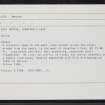East Wemyss, Jonathan's Cave
Burial(S) (Period Unassigned)
Site Name East Wemyss, Jonathan's Cave
Classification Burial(S) (Period Unassigned)
Alternative Name(s) Wemyss Caves
Canmore ID 53972
Site Number NT39NW 31.03
NGR NT 345 972
Datum OSGB36 - NGR
Permalink http://canmore.org.uk/site/53972
- Council Fife
- Parish Wemyss
- Former Region Fife
- Former District Kirkcaldy
- Former County Fife
NT39NW 31.03 345 972
A skeleton, head to the west, arms folded across the chest, eroded from the beach, to the west of Jonathan's Cave (NT39NW 9). Long bones and skull well preserved, remainder badly fragmented. No cist, no coffin, no finds, but burial possibly on a pebble floor/base. Remains deposited with Fife Archaeological Index by police.
D Provan 1988.
This skeleton was studied by Dr S Whiten. It proved to be male, c30-40 years, robust with no observed pathology, height 170cm (5 ft 8 inches). The skeleton was submitted to Historic Scotland to send for C14 dating in Glasgow. This date is GU 3038 980 +/- 80 delta 13C = - 19.9% conventional years BP (ie before 1950 AD). The calibrated dates are AD 970 - AD 1120 (69.72 probability) and AD 890 - AD 1220 (probability 95.76).
Sponsors: HS, Fife Archaeological Index.
E Proudfoot 1991.
Publication Account (1987)
The caves formed in the sandstone cliffs to the northeast of East Wemyss have been the focus of antiquarian and archaeological interest since 1865 when Professor James Young Simpson visited them and found their walls 'to be covered at different points with representations of various animals, figures and emblems'. What particularly excited the discoverers was that several of the the incised markings could be compared to those on Pictish symbol stones, the significance of which was at that time becoming apparent as a result of John Stuart's work on cataloguing them. Careful drawings of the markings were made for the second volume of Stuart's 'The Sculptured Stones of Scotland' (published in 1867) and these, amplified by photographic surveys in the early years of this century and again in the 1920s, have provided the basic record. Between 1984 and 1985 further drawing was undertaken, and it is clear that several areas of carvings have been lost, and perhaps even more sadly other markings in 'Pictish style' have been added; here we list only the most interesting and apparently authentic markings.
...Jonathan's Cave (or the Factor's Cave) contains many distinctive symbols of Pictish date, as well as several much later examples, including a 19th century cannon; particularly well-preserved are the double-disc symbols, an upright 'fish', several animals, and on the opposite wall an oared ship.
Information from ‘Exploring Scotland’s Heritage: Fife and Tayside’, (1987).
Excavation (1988)
A skeleton, head to the west, arms folded across the chest, eroded from the beach, to the west of Jonathan's Cave (NT39NW 9). Long bones and skull well preserved, remainder badly fragmented. No cist, no coffin, no finds, but burial possibly on a pebble floor/base. Remains deposited with Fife Archaeological Index by police.
D Provan 1988.








